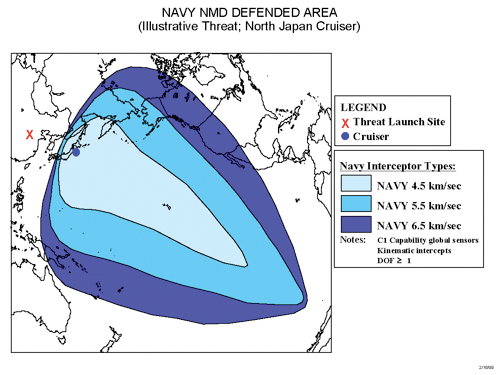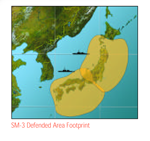I attended the Arms Control Association’s Avoiding Renewed U.S.-Russian Strategic Competition panel (remarks online transcript coming) yesterday.
During the question and answer session, Representative Ellen Tauscher mentioned that a viable alternative to the European GMD site is a combination of mobile midcourse (Aegis SM-3) and terminal defenses (PAC-3, THAAD) to defend Europe.
Tauscher has been proposing mobile assets as an alternative to the fixed site in Poland, including a talk at the Atlantic Council and during a budget hearing with MDA Director General Obering. Obering was obviously aware of the proposal, because his prepared statement included a long dismissal of the mobile systems that asserted the Navy would need 40 Aegis ships to defend Europe:
There has been some discussion that the defense of all of Europe from ballistic missile attack would be more cost-effective if we were to replace the fixed missile field, midcourse radar and forward-deployed radar currently planned for Europe with mobile missile defenses. By our calculations, this is clearly not the case. There are serious drawbacks to planning an architecture of mobile systems in lieu of the currently planned fixed architecture.
First, the current configurations of Aegis BMD and Terminal High Altitude Area Defense do not have the ability to counter intercontinental ballistic missiles (ICBMs) without extensive and costly modifications. Likewise, mobile system sensors for Aegis BMD and THAAD cannot provide equivalent radar coverage of Europe. They are designed to be augmented with other sensors, like the European Midcourse Radar, and their interceptors are designed to engage slower short- to medium-range ballistic missiles systems. Without sensor augmentation, Aegis BMD ships, using the SM-3 Block IIA (currently under development and not available until after 2015), would protect approximately only half of Europe against longer-range missiles. Furthermore, the THAAD interceptor would require extensive redesign to be able to intercept long- range threat missiles. Importantly, if these mobile short-range systems achieved an intercept, the intercept would occur in the lower parts of the atmosphere where post-engagement effects, such as chemical, biological, or nuclear weapon fallout and electro- magnetic pulse effects would be of great concern to cities and other civilian areas.
Second, the protection of Europe with mobile systems such as Aegis BMD and THAAD would come at a cost that is more than five times greater to field and sustain when compared to the fixed BMD site plan. It will require 10 Aegis ships on station with SM-3 Block IIA interceptors to provide 40 to 60% coverage of Europe (central Europe would not be protected). To provide this persistent partial coverage, it would require four rotations for a total of 40 ships dedicated to the European defense. Assuming 20 interceptors per ship, we would need 200 SM-3 interceptors for the ships on station and 200 SM-3 interceptors for rotation. This mobile system alternative will initially cost $17 billion, with recurring costs around $600 million per year. The command and control infrastructure required to support this mobile alternative would make this approach even more cost-prohibitive. Of note, we did not consider the significant impact on our Aegis ship force levels in this calculation.
The cost for deploying 80 THAAD batteries (the minimum estimate to protect key assets Europe) would be approximately $40 billion with recurring costs at roughly $2.4 billion per year. The cost to field this additional force structure and the need to negotiate with each host nation also makes this option prohibitively expensive and not viable. I believe our current proposed architecture will provide the best, most cost effective protection for our European allies, and it can be deployed beginning in 2011. It would protect all European nations threatened by longer-range weapons from Iran. The cost of our European Missile Defense component proposal of $3.5 billion non-recurring, and $250 million per year to operate and maintain, is far less expensive and more effective than the $16 billion, or more, and the $600 million per year required for a less effective mobile ballistic missile defense architecture for Europe. The mobile alternative also would not provide any additional protection for the United States.
When I read this, I though 40?
As in FOUR ZERO? Is this like the biblical 40? As in “We don’t know how many, because we only have eyes for ground-based midcourse”?
The Aegis defended area or footprint is supposed to be much, much bigger than Obering’s remarks would suggest. Early on, when the Navy anticipated an interceptor with 4.5 km/s burnout velocity, DOD was releasing defended area charts that looked like this.
That’s a single Aegis cruiser covering all of Japan and Hawaii in a 25,000 square kilometer shadow. Don’t tell me you need 10 of these suckers to “to provide 40 to 60% coverage of Europe.”
(I think General Obering means “our NATO allies” rather than the cultural concept or the political enterprise of integration. Picture chain-smoking Parisians sipping espresso with one snickering “The threat to Europe is not from missiles, but ennui” and the other adding, “Not from Iran, but Turkey.”)
Admittedly, the current SM-3, with a 13.5” diameter, has a burnout velocity of only 3.0-3.5 m/s, resulting in a much smaller defended area as you can see from this Raytheon fact sheet (right).
But the 21” version—which the United States is already cooperatively developing with Japan—is supposed to have 40-60 percent better burnout velocity, between 4.5-5.0 m/s.
Such an interceptor—supplemented with the appropriate terminal defenses—ought to be able to defend most of Europe with much fewer than ten ships. I would think 2-4 ships based in some combination of the Mediterranean, Black and North Seas would do it. Of course, that’s a guesstimate, from looking at the geography.

Feel free to imagine your own operational concepts.
My sense is that Obering is cooking the books, with at least two assumptions designed to skew the results.
1. Lame Radars: Obering compares the European interceptor site with a radar, to a network of Aegis ships without a radar.
Guess what that does? Decreases the size of the defended area for each ship, increasing the number required. This is how the National Academies explained the effect in a study of the old Navy Theater Wide architecture:
The weakest link … is the detection capability the Navy will obtain by evolutionary improvement of Aegis’s SPY-1 radar. In geographic situations where the NTW ship can be placed near the TBM launch point, the protected region can be very large. However, in situations where the NTW ship is near the TBM aim point, the protected region can be very small, limited as it is by SPY-1’s detection capability.
If I had to guess, Obering is also assuming that he wants multiple shots from ships in different locations. But let’s just assume, in the mobile scenario, that the US either builds the radar in the Czech Republic or takes Putin up on his offer to put the X-band radar in Azerbaijan, so we compare a fixed site in Poland with mobile assets.
2. 24 Hour Alerts Obering assumes that one needs to keep all ten ships at sea at all times (thus quadrupling the ship requirements), rather than simply deploying them during a crisis.
Why?
The ground-based interceptors aren’t going to be kept on alert at all times. (See: “Deployed GMD System May Not Be Operational Around the Clock,” Inside Missile Defense, Feb. 5, 2003.) Aegis could operate like the Airborne Laser, heading out out to sea in times of a crisis or conflict.
***
Reducing the number of ships required by an order of magnitude from forty to four would make the mobile option much, much more attractive.
Of course, all of this assumes the interceptors work—an important assumption. Although I have my doubts about both systems, on this score again, the Raytheon SM-3 has the superior test record.
I don’t get it. The Aegis system is clearly the most functional of our missile defense assets, yet the MDA seems to hate it. Why?



I don’t get it. The Aegis system is clearly the most functional of our missile defense assets, yet the MDA seems to hate it. Why?
Your confusion is produced by a mistaken assumption about the intent of the MDA program. The purpose is to provide for more American military bases, not for greater protection from missiles. A sea-borne platform would not require a garrison. It is the imperial imperative.
I don’t get it. The Aegis system is clearly the most functional of our missile defense assets, yet the MDA seems to hate it. Why?
I know some folks over on the acquisition side of things at the MDA and it seems like their disdain for Aegis is a classic case of the Not Invented Here syndrome.
MDA bureaucrats love ground-based mid-course, the ABL and THAAD because they’ve held a lot of sway over each project. PAC-3 and Aegis BMD are a different story altogether.
The Army and Navy laid the groundwork for the PAC-3 and Aegis BMD back in the 1980s. This gave both systems about two decades to seriously mature before the MDA evolved into the reasonably-strong organization it is today under President Bush.